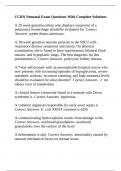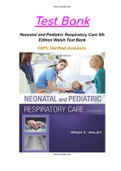Neona - Study guides, Class notes & Summaries
Looking for the best study guides, study notes and summaries about Neona? On this page you'll find 1411 study documents about Neona.
Page 4 out of 1.411 results
Sort by
CCRN Neonatal Exam Questions With Complete Solutions

-
CCRN Neonatal Questions and Answers Rated A+
- Exam (elaborations) • 54 pages • 2024
-
- $12.49
- + learn more
A deformation is a(n) abnormality caused by unusual mechanical forces on normal tissue. A low birth weight infant's temperature increases during skin-to-skin care. This is an example of heat transfer by conduction. At the onset of labor the release of catecholamines stimulates increased absorption of lung fluid. An edematous, bruised lesion on the right anterior scalp where the vacuum was applied. This lesion has clearly demarcated edges, is firm to touch, and does not cross the suture li...
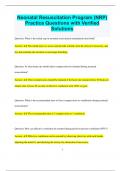
-
Neonatal Resuscitation Program (NRP) Practice Questions with Verified Solutions
- Exam (elaborations) • 23 pages • 2024
-
Available in package deal
-
- $9.99
- + learn more
Neonatal Resuscitation Program (NRP) Practice Questions with Verified Solutions Question: What is the initial step in neonatal resuscitation immediately after birth? Answer: The initial step is to assess and provide warmth, clear the airway if necessary, and dry and stimulate the newborn to encourage breathing. Question: At what heart rate should chest compressions be initiated during neonatal resuscitation? Answer: Chest compressions should be initiated if the heart rate remai...
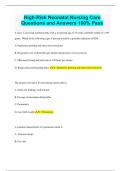
-
High-Risk Neonatal Nursing Care Questions and Answers 100% Pass
- Exam (elaborations) • 46 pages • 2024
-
Available in package deal
-
- $11.99
- + learn more
High-Risk Neonatal Nursing Care Questions and Answers 100% Pass A nurse is assessing a preterm baby with a gestational age of 32 weeks and birth weight of 1,389 grams. Which of the following signs if present would be a possible indication of RDS. A. Expiratory grunting and intercostal retractions. B. Respiratory rate of 46 breaths per minute and presence of acrocyanosis. C. Mild nasal flaring and heart rate of 140 beats per minute. D. Bradycardia and bounding pulse A. Expiratory gruntin...
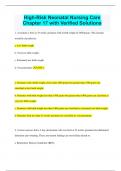
-
High-Risk Neonatal Nursing Care Chapter 17 with Verified Solutions
- Exam (elaborations) • 24 pages • 2024
-
Available in package deal
-
- $9.99
- + learn more
High-Risk Neonatal Nursing Care Chapter 17 with Verified Solutions 1. A neonate is born at 33 weeks' gestation with a birth weight of 2400 grams. This neonate would be classified as: a. Low birth weight b. Very low birth weight c. Extremely low birth weight d. Very premature ANS: a a. Neonates with a birth weight of less than 2500 grams but greater than 1500 grams are classified as low birth weight. b. Neonates with birth weight less than 1500 grams but greater than 1000 grams are...
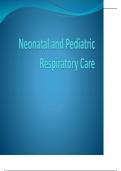
-
Neonatal and Pediatric Respiratory Care Presentation Latest 2024-2025
- Exam (elaborations) • 169 pages • 2024
-
- $19.49
- + learn more
Neonatal and Pediatric Respiratory Care Presentation Latest . Embryonic Development of the Lung B. Development of the Fetal Heart: 1. When the heart first develops, it’s nothing more than a tube formed from the fusion of two other tubes. 2. By day 22 or 23 after conception, which is week five of pregnancy, the heart begins to beat and can be seen on vaginal ultrasound as a tiny flicker. 3. The developing heart, nothing more than a tube, consist of 3 layers and 3 specific areas. 4. The...

-
Obstetrics and Neonatal Care Chapter 34: Questions and Answers 100% Solved
- Exam (elaborations) • 31 pages • 2024
-
Available in package deal
-
- $9.99
- + learn more
Obstetrics and Neonatal Care Chapter 34: Questions and Answers 100% Solved The first stage of labor ends when: A. the presenting part of the baby is visible. B. contractions are less than 10 minutes apart. C. the mother experiences her first contraction. D. the amniotic sac ruptures and labor pains begin. A. the presenting part of the baby is visible. A 23-year-old woman, who is 24 weeks pregnant with her first baby, complains of edema to her hands, a headache, and visual disturbanc...
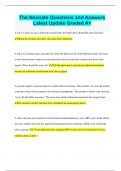
-
The Neonate Questions and Answers Latest Update Graded A+
- Exam (elaborations) • 18 pages • 2024
-
Available in package deal
-
- $9.99
- + learn more
The Neonate Questions and Answers Latest Update Graded A+ A nurse is about to give a full-term neonate their first bath. How should the nurse proceed? Bathe the neonate only after vital signs have stabilized. A nurse is assisting with a circumcision. After the physician has started the procedure, the nurse reviews the neonate's medical record and notices that an informed consent form hasn't been signed. What should the nurse do? Tell the physician to stop the procedure immediately ...
Neonatal and Pediatric Respiratory Care 5th Edition Walsh Test Bank . "To Clarify this is a test bank not a textbook . Instant Download . PDF Printed ."
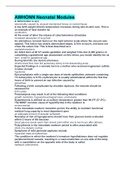
-
AWHONN Neonatal Modules Test (Answered) Verified Solution 100%
- Exam (elaborations) • 21 pages • 2022
- Available in package deal
-
- $10.74
- 1x sold
- + learn more
AWHONN Neonatal Modules A deformation is a(n) abnormality caused by unusual mechanical forces on normal tissue. A low birth weight infant's temperature increases during skin-to-skin care. This is an example of heat transfer by conduction. At the onset of labor the release of catecholamines stimulates increased absorption of lung fluid. An edematous, bruised lesion on the right anterior scalp where the vacuum was applied. This lesion has clearly demarcated edges, is firm to touch, and doe...

Did you know that on average a seller on Stuvia earns $82 per month selling study resources? Hmm, hint, hint. Discover all about earning on Stuvia

